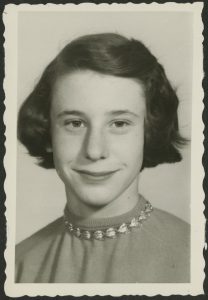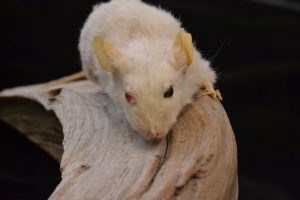"I answer to myself": Dr. Florence Haseltine and her path to women's health advocacy
By Sarah Oswald
Florence Haseltine's papers are now available to researchers. We encourage you to explore the full description and inventory.

Dr. Florence Haseltine knew from a very young age that she was destined for great things. Florence Pat Haseltine was born in 1942 in Philadelphia, Pennsylvania and grew up near the Naval Weapons Station in China Lake, California. She is the eldest child of William and Jean E. Haseltine and her father was a physicist for the military. Her experience growing up on a military base and within a neighborhood full of scientific households shaped her determination and set the course for her career as a biophysicist, reproductive endocrinologist, journal editor, novelist, inventor, and advocate for women's health.
“I'm going to go to MIT and get a Ph.D. in physics. I said that at six, and that's what I did.”
After graduating from High School, Dr. Haseltine attended college at the University of California at Berkeley, where she studied physics, then biophysics. Dr. Haseltine was one of only a few women in this academic major in a time when most physics majors were men. True to her six-year-old proclamations, Dr. Haseltine graduated from University of California at Berkeley in 1964 and was accepted in the Biophysics graduate program at the Massachusetts Institute of Technology [MIT].

In defiance of her father's and first husband's objections, Dr. Haseltine resolved to fulfill yet another childhood dream: “I decided I was going to be a research doctor…I decided I was going to be a human geneticist when I was about 18, I realized that being a doctor was probably the best thing, that if I had a good science background, I would be, ‘unstoppable.'” After finishing at MIT, she applied to medical school and was accepted at the Albert Einstein College of Medicine.
After successfully completed her internship at the University of Pennsylvania at Philadelphia and her residency at the Boston Hospital for Women (now Brigham and Women's Hospital) in 1976, Dr. Haseltine accepted a fellowship position at Yale University from 1976-1978. She later served as an assistant professor, then associate professor, in the Department of Obstetrics, Gynecology, and Pediatrics at Yale University.

During her fellowship, Dr. Haseltine worked within Dr. Frank Ruddle's lab where she learned to fuse mouse embryos and create mosaic mice. This work provided Dr. Haseltine with experience handling embryos and charted the course for her further research on in vitro fertilization. The Yale Fertility Center was one of the first IVF clinics in the United States and in 1983 it was the fifth lab in the nation to have an IVF baby.
Despite her qualifications and research involvement, Dr. Haseltine did not obtain tenure at Yale University. Dr. Haseltine characterized her experiences applying for jobs in the 1980s and 1990s as paving the way for other women: “Lot of things that were happening because I was female. I mean, during the period of the late 80s early 90s, when they wanted to have women interviewed for everything, I was a token on many many job interviews. And finally, that sort of stopped in the mid-90s… and you know you're a token and all kinds of things show it, but you figure you might as well go through with it because maybe it will help people in the future… Since I know what women did ahead of me influenced what I could do, you can only hope that what you did helped some of them.”

From 1985 to 2012, Dr. Haseltine served as the Director of the Center for Population Research at the National Institutes of Child Health and Human Development at the National Institutes of Health [NIH]. The health of women and their advancement professionally are central issues for Dr. Haseltine: “When I got to there [NIH], OB/GYN just was not considered a real field.” During her time at the NIH she worked with government lobbyist to help increase funding for women's health research at the national level. In addition to working towards increased funding for women's health research, Dr. Haseltine also spent her time at the NIH advocating for the increased participation of women in clinical trials. The direct result of Dr. Haseltine's efforts was the creation of the Office of Research on Women's Health at the NIH in 1990.
“I have bought into the American idea that things should be equitable and it's a very powerful idea in this country. It's not true in other countries… Later in life, getting women in clinical trials was based on an equitable argument.”
Further Resources
Florence Haseltine Papers Finding Aid
Related materials located at outside repositories:
The processing of the archival material at Drexel University Legacy Center was made possible by Dr. Florence Haseltine, M.D., Ph. D., Haseltine Systems, Inc., and the Conway-Welch Family Foundation. The Legacy Center would like to thank Dr. Haseltine for her generous support and commitment to preserving the history of women in medicine.
In addition, and in stride with Dr. Haseltine's use of technology throughout her career, the Florence Haseltine papers include a variety of born digital materials. Project Archivist Sarah Oswald has taken this opportunity to research best practices, establish workflows, and explore the software necessary for launching the Legacy Center's management of electronic records.